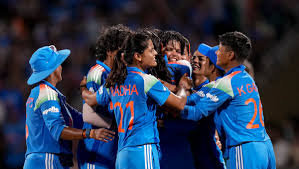By Anusha Subramanian
Something shifted in India two weeks back. A women’s cricket semi-final, not a men’s match, not a token fixture, filled up DY Patil Stadium. Not because someone distributed free passes, but because people wanted to be there. Tickets sold for as little as ₹100, yet the boards still read SOLD OUT. Jersey sellers outside were rushing to restock No. 5 shirts because Jemimah Rodrigues’ name suddenly carried weight. That’s not charity, that’s demand. That’s cultural change happening right before our eyes.
Inside the stadium, it wasn’t polite applause echoing through the stands; it was raw, full-throttle fandom. People debated field placements, scores, and bowling changes. College girls argued about who should take over next. Men dissected the pitch with the seriousness of commentators. One young boy craned his neck the entire match, unwilling to miss a single delivery. That image says it all, children growing up watching women play at the centre of the field, not on the margins. Instagram was filled with reels of male kids finding their inspiration in Jemima, Deepti, Shefali and the others.
None of this happened overnight. Women’s cricket has fought long and hard against invisibility, unequal pay, limited exposure, and the constant question, “Who will watch women play?” Well, India has answered that. Everyone will, once you build a system that values talent and tells the right stories.
When the BCCI finally announced equal match fees in 2023, it was hailed as a breakthrough, and it was. It also reminded us how long women had been short-changed. They’d done the same work, often in harder conditions, with more scrutiny and less reward. Equality wasn’t generosity. It was a correction.
Women’s cricket has indeed come a long way. Today, people talk about it with excitement, wait eagerly for matches, and proudly wear jerseys of their favourite players. The Women’s Premier League has changed the landscape. Players are now paid on par with their male counterparts. This progress rests on the shoulders of the pioneers, women like Anjum Chopra, Jhulan Goswami, and Mithali Raj, who played purely out of passion when recognition and resources were scarce. They didn’t just play matches; they laid the foundation for an entire ecosystem to stand tall.
As Jemimah Rodrigues said in her post-match conversation with the President, “This World Cup is as much theirs as it is ours. The seeds were sown by them; we are harvesting the fruits today.” This win, India’s first-ever ICC Women’s World Cup, came after half a century of heartbreak starting with the first World Cup in 1973. In just the past two and a half decades Anjum Chopra’s team fell short in the early 2000s, India lost in 2005 and 2017, and Jhulan’s last World Cup in 2022 ended without a trophy. Twice, Mithali Raj led her team to the finals but the cup remained elusive. This year’s victory is a tribute to their perseverance.
What stood out this time wasn’t just skill, but solidarity. The team stood by each other through pressure and setbacks. Because a team isn’t defined by its wins, but by how many times it falls and rises again, stronger each time. The credit also goes to their coach Amol Mazumdar, who, laid immense trust in these girls, realising each one’s potential with his coaching, only to prove that women are no less in a male-dominated game like Cricket.
It’s not just women’s cricket that’s taken time to earn its due. Women’s hockey went through the same struggle. For years, the players fought for facilities, funding, and attention. Even when they reached international finals, their stories were barely told. Their grit went unnoticed until the nation finally saw them as equals on the field, not as footnotes to the men’s game.
The same story plays out in adventure sports, particularly mountaineering. The difference is mountaineering isn’t even recognised as a “sport” yet. Despite hundreds of women earning mountaineering certifications in India, you can count the number of women mountain guides on your fingers. Why? Because jobs for women in guiding are few and far between.
And this isn’t unique to India. Nepal, whose economy thrives on trekking and mountaineering, faces the same reality. There are barely any women guides leading expeditions. It’s not a lack of competence; it’s a lack of acceptance. What’s needed is a mindset shift, the belief that women can lead in the outdoors.
As Guneet Puri, founding partner of Bohemian Adventures, an all-women-run adventure company, explains, “We started our business because there was a clear lack of women guides in the mountains. Despite being highly qualified, certified and experienced, we couldn’t find meaningful employment in the adventure industry. The only way to pursue our passion professionally was to create our own venture.”
Through Bohemian Adventures, Guneet and her team now take women interns on treks and expeditions, giving them real guiding experience, a chance to learn, lead, and join the outdoor workforce as equals.
She adds, “The biggest challenge has been changing people’s mindset about women as trek and expedition leaders. You can’t brush that under the carpet. The male-to-female ratio in this industry is drastically skewed. There are fewer than a hundred women in India professionally involved in adventure sports. We’ve faced stigma, doubt, and endless scrutiny. We’ve been judged not just for our physical strength, but for our roles as daughters, wives, and mothers, as if competence has a gender.”
“When I began, there were barely any women in guiding or leading treks. Even today, women guides in adventure are still rare. But we’re changing that, one expedition at a time. When I’m leading a trek – whether in Nepal or in India, I insist on having at least one woman guide on the team. It’s up to us to break paths for the next generation of women to walk with confidence and claim their place in the vast wilderness,” Says Dilshad Master Kumar. Dilshad spent three decades leading media organisations before leaving it all behind to pursue her passion for the outdoors. A cancer survivor and now a certified mountain guide, she leads both children and adults into the wilderness, where adventure and healing go hand in hand.
Nearly a decade later, things are shifting. Women guides have proven their capability time and again. Today, many male counterparts and climbers trust them implicitly, the kind of trust that matters most when your life depends on your team. But Guneet is honest about the journey ahead,
“This is still a small circle. We’ve won respect from some, but there’s a long way to go in changing the larger perception of women guides.”
Whether on the pitch or a mountain ridge, the pattern is the same. Progress demands persistence, and acceptance takes time.
Cricket showed us that when women are given the stage, they don’t just participate, they elevate the game. Adventure is walking the same road. The day is not far when people will see women mountaineers not as exceptions, but as equals, leaders, guides, and changemakers in their own right.
The cheers at DY Patil Stadium weren’t just for a match. They were for every woman who dared to dream in silence and kept showing up until the world finally noticed.
When women play, climb, lead, or guide, they aren’t just reaching summits; they’re raising the bar for what’s possible. And one day soon, the mountains, like that stadium, will echo with applause, not for charity, but for competence. For courage. For women who never stopped showing up.


